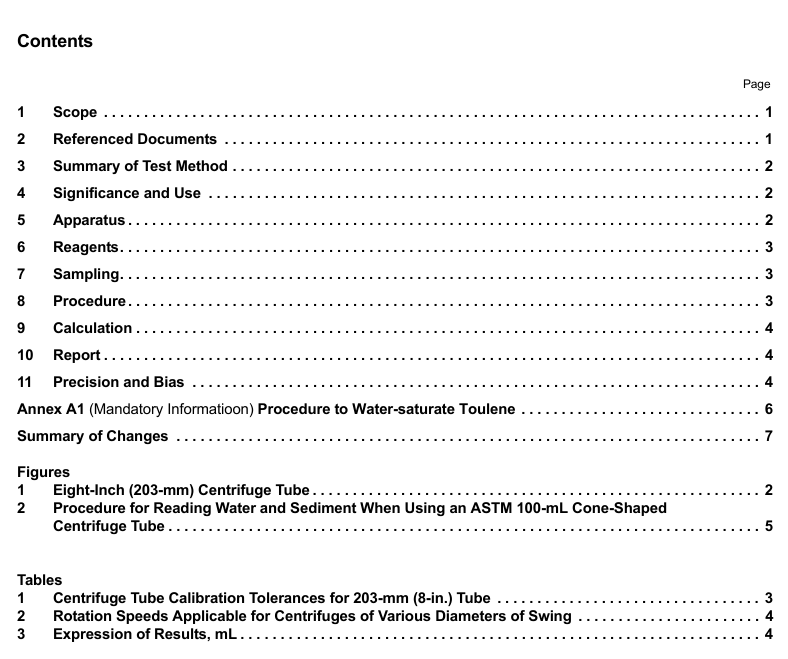API MPMS 10.6 pdf download

API MPMS 10.6 pdf download Manual of Petroleum Measurement Standards Chapter 10.6 Standard Test Method for Water and Sediment in Fuel Oils by the Centrifuge Method (Laboratory Procedure)
6.1.2 The solvent shall be water-saturated at 60 6 1°C (140 6 1.8°F) but shall be free of suspended water. See Annex A1 for the solvent-water saturation procedure.
6.2 Demulsifiers:
6.2.1 Where necessary, use a demulsifier to promote the separation of water from the sample, to prevent water from clinging to the walls of the centrifuge tube, and to enhance the distinctness of the water-oil interface.
6.2.2 When using a demulsifier, it should be mixed accord- ing to the manufacturer’s recommendations and should never be added to the volume of sediment and water determined. Always use the demulsifier in the form ofa demulsifier-solvent stock solution or be premixed with the solvent to be used in the test.
7. Sampling
7.1 Sampling is defined as all steps required to obtain an aliquot ofthe contents ofany pipe, tank, or other system and to place them into the laboratory test container.
7.2 Only representative samples obtained as specified in Practice D4057 (API MPMS Chapter 8.1) and Practice D4177 (API MPMS Chapter 8.2) shall be used for this test method.
7.3 Practice D5854 (API MPMS Chapter 8.3) contains additional information on sampling and homogenization effi- ciency of an untested mixer. Do not use this test method without strict adherence to Practice D5854 (API MPMS Chapter 8.3).
8. Procedure
8.1 Fill each of two centrifuge tubes (5.2) to the 50-mL mark with the well-mixed sample directly from the sample container. Using a pipette, add 50 mL of the water-saturated solvent (6.1). Read the top of the meniscus at both the 50 and 100 mL marks. Stopper the tubes tightly and shake vigorously until the contents are thoroughly mixed. Loosen the stoppers on the tubes and immerse the tubes to the 100-mL mark for 10 min in the bath maintained at 60 6 1°C (140 6 1.8°F).
8.2 Tighten the stoppers and again invert the tubes to ensure that the oil and solvent are uniformly mixed and shake cautiously. (Warning—In general, the vapor pressures of hydrocarbons at 60°C (140°F) are approximately double those at 40°C (104°F). Consequently, invert the tubes at a position below eye level so that contact will be avoided if the stopper is blown out.)
8.3 Place the tubes in the trunnion cups on opposite sides of the centrifuge to establish a balanced condition and ensure that the tubes and stoppers do not touch adjacent or opposite tubes when in the extended position. Spin for 10 min at a rate, calculated from the equation given in 5.1.6, sufficient to produce a relative centrifugal force (rcf) of between 500 and 800 at the tip of the whirling tubes (see Table 2 for the relationship between diameter of swing, relative centrifugal force, and revolutions per minute). Maintain the temperature of the sample during the entire centrifuging procedure at 60 6 1°C (140 6 1.8°F). (See Note 4.)
8.4 Immediately after the centrifuge comes to rest following the spin (ensure the tubes are immediately brought to a vertical position after the centrifuge stops because the results may be affected if the tubes come to rest at an angle), read and record the combined volume of water and sediment at the bottom of each tube to the nearest 0.05 mL from 0.1 to 1-mL graduations and to the nearest 0.1 mL above the 1-mL graduations. Below 0.1 mL, estimate to the nearest 0.025 mL (see Fig. 2). If less than 0.025 mL of water and sediment is visible and it is not a great enough volume to be considered 0.025 mL, record the volume as less than 0.025 mL. If no water or sediment is visible, record the volume as 0.000 mL. Return the tubes without agitation to the centrifuge and spin for another 10 min at the same rate.
8.5 Repeat this operation until the combined volume of water and sediment remains constant for two consecutive readings. In general, not more than two spinnings are required.
8.6 Ifthe difference between the final volumes is not greater than one subdivision on the centrifuge tube (see Table 1), or, not greater than 0.0025 mL for estimated volumes of 0.10 mL or lower, proceed with the calculation of water and sediment content using Eq 5 as described in Section 9. If the difference is greater than one subdivision or, for readings of 0.10 or below, greater than 0.025 mL, the readings are inadmissible. If this is the case, repeat the determination starting at 8.1.









